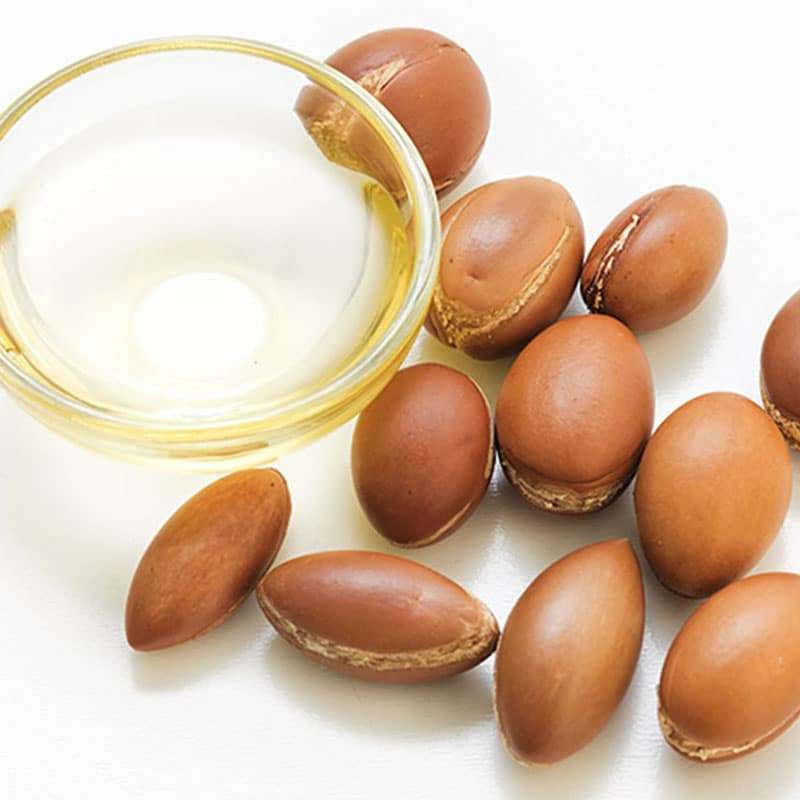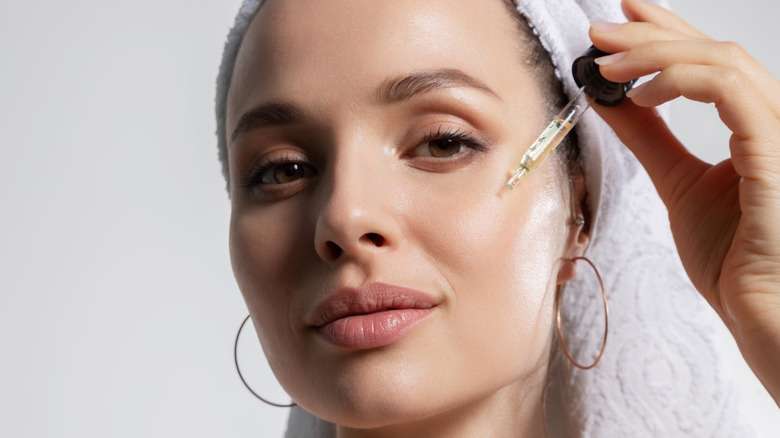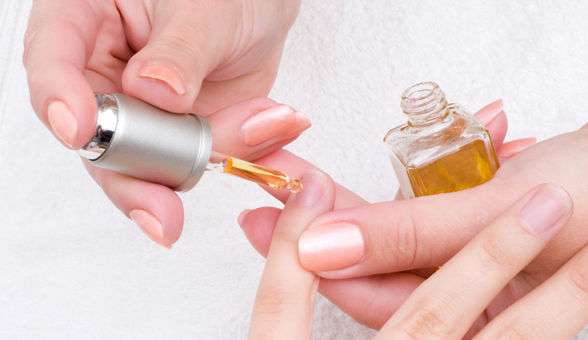Argan oil is rich in nutrients and antioxidants, including vitamin E, omega-3 fatty acids, and linoleic acid. It is commonly used in skincare products to help moisturize and nourish the skin, and has been shown to have anti-inflammatory and anti-aging properties. In recent years, argan oil has gained popularity around the world for its benefits in skincare, hair care, and culinary applications.
Argan oil has a long history of use in Morocco, where it is derived from the kernels of the argan tree (Argania spinosa). The tree is native to the southwestern region of Morocco and has been an important part of the local ecosystem and economy for centuries.
The traditional method of extracting argan oil involves collecting the fruit of the argan tree, which resembles a small, yellowish-green apple. The fruit is then dried in the sun, after which the outer layer is removed to reveal the hard, nut-like kernel inside. The kernels are then cracked open to extract the oil-rich seeds, which are then roasted and ground into a paste. The paste is then pressed to extract the oil, which is traditionally used for culinary, cosmetic, and medicinal purposes.
Today, Argan oil is still produced using traditional methods in Morocco, and it has been recognized by UNESCO as a protected cultural heritage of the country. It is important to note that not all argan oil is created equal, and it is important to choose a high-quality, pure oil in order to experience its full benefits.
ARGAN OIL SKINCARE BENEFITS
Argan oil can be used in a number of ways to benefit the skin. Here are some common ways to use argan oil for skin:
1) MOISTURIZER:
Argan oil is rich in vitamin E, antioxidants, and essential fatty acids, which make it an excellent natural moisturizer for the skin. It can help to hydrate and nourish the skin, leaving it soft, smooth, and supple.
After cleansing your skin, apply a few drops of argan oil onto your face and gently massage it in. This will help moisturize and nourish your skin, leaving it soft and supple. Argan oil is rich in essential fatty acids, antioxidants, and vitamin E, making it an excellent choice for nourishing and hydrating the skin.
When applied to the skin, argan oil can help to lock in moisture, leaving the skin feeling soft, supple, and hydrated. It also contains anti-inflammatory properties, which can help to soothe and calm irritated skin. Argan oil is also non-comedogenic, meaning it won’t clog pores or cause breakouts.
To use argan oil for skin moisturizing, apply a small amount to your face and neck after cleansing and toning. Gently massage the oil into your skin, focusing on any areas that feel dry or tight. You can also mix a few drops of argan oil into your moisturizer for an extra boost of hydration.
2) ANTI-AGING TEATMENT:
To help reduce the appearance of fine lines and wrinkles, apply argan oil to your face and neck before bed. You can also mix a few drops of argan oil with your favorite moisturizer for added benefits. It is rich in antioxidants, essential fatty acids, and vitamin E, which makes it a great option for anti-aging treatment.
The antioxidants in argan oil help to protect the skin from free radicals that can damage the skin and lead to premature aging. Free radicals are unstable molecules that are generated by environmental factors such as pollution, UV rays, and smoking. These molecules can damage the skin cells and cause wrinkles, fine lines, and age spots.
Argan oil also contains essential fatty acids such as linoleic acid and oleic acid, which help to moisturize the skin and improve its elasticity. This can help to reduce the appearance of wrinkles and fine lines. Additionally, argan oil contains squalene, which is a natural moisturizer that can help to hydrate the skin and improve its texture.
Vitamin E is another important component of argan oil. It is a powerful antioxidant that helps to protect the skin from damage caused by UV rays and other environmental factors. It also helps to promote the growth of new skin cells, which can help to reduce the appearance of fine lines and wrinkles.
To use argan oil for anti-aging treatment, apply a few drops of the oil onto your face and neck after cleansing and toning your skin. Gently massage the oil into your skin using circular motions until it is fully absorbed. You can use argan oil in the morning and at night as part of your daily skincare routine.
It is important to note that while argan oil can be beneficial for anti-aging, it is not a miracle cure. It should be used in combination with other anti-aging products and a healthy lifestyle that includes a balanced diet, regular exercise, and adequate sleep.
3) ACNE TREATMENT:
Argan oil is a non-comedogenic oil, which means that it does not clog pores. It can provide hydration to the skin without causing breakouts or exacerbating acne.
To use argan oil for acne, you can apply a few drops of the oil directly to clean, dry skin. It is best to use a small amount at first and to gradually increase the amount as your skin becomes accustomed to it. You can also look for skincare products that contain argan oil as an ingredient.
However, it’s important to note that everyone’s skin is unique, and what works for one person may not work for another. If you have severe or persistent acne, it’s best to consult with a dermatologist for personalized treatment recommendations.
4) LIP BALM:
Argan oil can be used as a natural lip balm to help moisturize and protect your lips. It can be a great ingredient for making lip balm as it is rich in vitamin E and essential fatty acids, which can help moisturize and protect the delicate skin of the lips.
HOMEMADE ARGAN OIL LIP BALM RECIPE
Ingredients:
- 1 tablespoon beeswax pellets
- 1 tablespoon shea butter
- 1 tablespoon argan oil
- 5-10 drops of essential oil (optional)
DIRECTIONS:
- In a double boiler, melt the beeswax and shea butter together over low heat.
- Once melted, remove from heat and add in the argan oil and essential oil (if using) and stir well.
- Pour the mixture into small lip balm containers and let it cool and solidify.
- To use, simply apply a small amount of the lip balm onto your lips as needed throughout the day.
Note: If you’re allergic to beeswax, you can substitute it with candelilla wax or carnauba wax for a vegan alternative.
5) EYE SERUM:
To help reduce the appearance of dark circles and puffiness around the eyes, apply a drop of argan oil to the under-eye area and gently massage it in. When used as an eye serum, argan oil can help to moisturize and protect the delicate skin around the eyes, which can be prone to dryness, fine lines, and wrinkles. To use argan oil as an eye serum, you can follow these steps:
- Start with clean, dry skin. Gently wash your face with a mild cleanser and pat it dry with a towel.
- Dispense a small amount of argan oil onto your fingertips. You can use a dropper or a pump to dispense the oil, depending on the packaging of your product.
- Gently dab the oil around your eyes, being careful not to get it into your eyes. Use your ring finger to apply the oil, as this finger tends to exert less pressure and is less likely to pull or tug at the delicate skin around the eyes.
- Allow the oil to absorb into your skin. You can follow up with your usual moisturizer or sunscreen if desired.
It is important to note that argan oil may not be suitable for everyone, particularly if you have oily or acne-prone skin. If you experience any irritation or breakouts after using argan oil, discontinue use and consult a dermatologist.
6) MAKEUP REMOVER:
Argan oil can be used to gently remove makeup from the skin without stripping it of its natural oils. Also argan oil is a great option for makeup removal because it is gentle on the skin and can effectively remove even stubborn makeup without causing irritation. It is also rich in antioxidants, essential fatty acids, and vitamins, which can help nourish and hydrate the skin while removing makeup.
To use argan oil as a makeup remover, simply apply a small amount of the oil to a cotton pad or ball and gently wipe it over your face to remove your makeup. You can also use your fingertips to massage the oil into your skin, which can help to loosen and dissolve makeup.
After using argan oil to remove your makeup, you may want to follow up with a gentle cleanser to ensure that all traces of makeup and oil are removed from your skin. You can also apply a few drops of argan oil to your skin as a moisturizer to help keep your skin soft and hydrated.
7) PROTECTON FROM SUN DAMAGE:
The antioxidants in argan oil can help protect the skin from the damaging effects of the sun. Argan oil has been traditionally used in Morocco for centuries for its various health and cosmetic benefits. One of the benefits of argan oil is that it can protect the skin from sun damage.
Argan oil is rich in antioxidants such as vitamin E, phenolic acids, carotenoids, and squalene, which can help protect the skin from harmful UV rays. The antioxidants in argan oil can neutralize free radicals that are produced by UV radiation, which can damage the skin and lead to premature aging. However, argan oil contains fatty acids, including oleic and linoleic acid, which can help improve the skin’s barrier function and reduce the risk of sunburn.
While argan oil can provide some protection against sun damage, it is important to note that it should not be used as a substitute for sunscreen. Sunscreen provides a more comprehensive protection against UV radiation, including UVA and UVB rays, and should be used daily to protect the skin from sun damage. Also, using argan oil in conjunction with sunscreen can provide added protection and nourishment to the skin.
8) ARGAN OIL FOR NAIL AND CUTICLE CARE:

Argan oil can be applied to nails and cuticles to moisturize and strengthen them, it is rich in vitamins, minerals, and antioxidants that can help to strengthen and nourish the nails and cuticles. The oil is also a great moisturizer, which can help to prevent dry and brittle nails and cuticles.
Here are some tips on how to use argan oil for nail and cuticle care:
- Apply a few drops of argan oil directly to your nails and cuticles and massage it in gently. You can do this once or twice a day, depending on your needs.
- Use argan oil as a base coat before applying nail polish. This will help to protect your nails from the harsh chemicals in nail polish and prevent them from becoming dry and brittle.
- Add a few drops of argan oil to warm water and soak your nails in the mixture for 10-15 minutes. This will help to soften the cuticles and make it easier to push them back.
- Apply argan oil to your nails and cuticles before going to bed and wear cotton gloves overnight. This will help the oil to penetrate deeply into the nails and cuticles and promote healthy growth.
In summary, argan oil is a natural and effective way to promote healthy nails and cuticles. It is also a great alternative to harsh chemicals that are often found in nail care products.
9) HEALING PROPERTIES:
Argan oil is rich in vitamin E and other nutrients that can help speed up the healing process of damaged skin.
Studies have shown that argan oil may have potential wound healing properties. It has been found to increase the rate of wound closure, reduce inflammation, and promote tissue regeneration, also the oil has antimicrobial properties, which may help prevent infection in wounds.
To use argan oil for wound healing, clean the wound thoroughly and apply a small amount of argan oil directly to the affected area. Cover the wound with a sterile bandage to prevent further infection. Repeat this process two to three times per day until the wound has healed.
However, it’s important to note that argan oil should not be used as a substitute for medical treatment for severe wounds. If you have a deep or infected wound, it’s important to seek medical attention from a healthcare professional.
10) STRECH MARKS:
Argan oil is rich in essential fatty acids, antioxidants, and vitamins, which can help to moisturize the skin and improve its elasticity.
Stretch marks occur when the skin is stretched beyond its limits, causing small tears in the skin’s tissue. These tears then appear as reddish or purple lines on the skin. Over time, the marks fade to a white or silver color, while stretch marks are not harmful to your health, they can be unsightly and cause self-consciousness.
To use argan oil for stretch marks, apply a small amount to the affected area and massage it into the skin in a circular motion. Do this twice a day, preferably in the morning and before going to bed. You can also mix argan oil with other natural ingredients such as coconut oil, aloe vera, or vitamin E oil for added benefits.
While argan oil may help to reduce the appearance of stretch marks, it is important to note that it may not completely eliminate them. It is also essential to maintain a healthy diet, exercise regularly, and stay hydrated to keep your skin healthy and prevent further stretch marks from forming. If you have concerns about the appearance of your stretch marks, consult with a dermatologist for treatment options.
11) ARGAN OIL FOR MASSAGE:
Argan oil is a popular choice for massage oil because it is lightweight, non-greasy, and easily absorbed into the skin. It also has moisturizing and nourishing properties that can help to soothe and hydrate the skin, making it ideal for use in massages.
To use argan oil for massage, you can follow these steps:
- Choose a high-quality, pure argan oil that is free from additives and preservatives.
- Warm up the oil by placing the bottle in warm water or by rubbing it between your hands.
- Apply a small amount of oil to your hands and rub them together to warm up the oil further.
- Begin massaging the oil into the skin using gentle, circular motions. Focus on any areas of tension or soreness, and adjust the pressure as needed.
- Continue massaging for as long as desired, making sure to reapply the oil as needed to keep the skin lubricated.
- After the massage, you can leave the oil on the skin to absorb, or you can wipe it off with a warm, damp cloth.
Remember, always do a patch test before using any new products on your skin, especially if you have sensitive skin or allergies. And if you have any underlying medical conditions, be sure to consult with a healthcare professional before using argan oil for massage.
12) UNEVEN SKIN TONE:
The fatty acids in argan oil, such as oleic and linoleic acid, can help to reduce inflammation and irritation in the skin. This can help to improve the appearance of uneven skin tone, including redness and blotchiness. The antioxidants in argan oil can also help to protect the skin from damage caused by free radicals, which can contribute to signs of aging and uneven skin tone.
To use argan oil for skin tone, apply a few drops of the oil to your face or body and massage it in gently. You can use argan oil as a moisturizer, or you can mix it with other oils or ingredients to create a customized skincare product. Be sure to choose a high-quality, pure argan oil for the best results.
In conclusion Argan oil can be used on its own as a moisturizer or incorporated into various skincare products such as creams, serums, and masks. It is suitable for all skin types, including dry, oily, and sensitive skin. Incorporating argan oil into your skincare routine can provide numerous benefits for your skin’s health and appearance.
